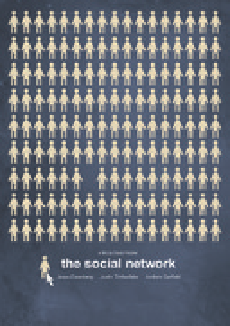Information Technology Reference
In-Depth Information
From these beginnings, new companies such as Facebook (
B.11.14
) and
Twitter have now emerged. Facebook is a social networking site whose users
can share personal updates, photos, and other information with their friends
(
Fig. 11.27
). Twitter is a microblogging service that lets a person send brief text
messages up to 140 characters in length to a list of followers. Twitter's celebrity
“tweeters” can attract millions of followers (
Fig. 11.28
).
Berners-Lee disagrees that Web 2.0 constitutes an essentially new vision for
the web and dismisses it as marketing jargon:
Web 1.0 was all about connecting people. It was an interactive space, and
I think Web 2.0 is, of course, a piece of jargon, nobody even knows what it
means. If Web 2.0 for you is blogs and wikis, then that is people to people. But
that was what the Web was supposed to be all along.
24
Fig. 11.27. The founding of Facebook
was made into a movie called
The Social
Network
. The marketing slogan for the
movie was “You don't get to 500 million
friends without making a few enemies.”
Instead, Berners-Lee is looking toward what he calls a “Semantic Web” in which
machines can process and understand the actual data on the web:
The Semantic Web is not a separate Web but an extension of the current
one, in which information is given well-defined meaning, better enabling
computers and people to work in cooperation. The first steps in weaving
the Semantic Web into the structure of the existing Web are already under
way. In the near future, these developments will usher in significant
new functionality as machines become much better able to process and
“understand” the data that they merely display at present.
25
Industry has taken the first small steps toward such a semantic future. The
search-engine companies Google, Microsoft, Yandex, and Yahoo! have agreed
on a common vocabulary with which website managers can mark up their sites
so that search engines can understand the nature of the content (schema.org).
By inserting
microdata -
a set of machine-readable tags introduced with HTML5,
the fifth revision of HTML - into the web page, and by using the agreed vocab-
ulary, the website can specify the type of content on the site. For example does
the website refer to
Casablanca
the movie or Casablanca the place? The search
engine can now distinguish between the sites and better address the user's
query. These improvements are all part of the need to go beyond searching and
better understand the user's intent.
Fig. 11.28. The Twitter service was intro-
duced in 2006 and in 2013 had more than
half a billion users. Twitter is an Internet
text-messaging service that allows a maxi-
mum message size of 140 characters.
B.11.14. Mark Zuckerberg was still an undergraduate student at Harvard when he came up with
the idea of using the web to link together a network of friends with a social networking website.
This modest beginning has now evolved into the social networking company Facebook.



Search WWH ::

Custom Search